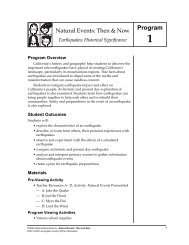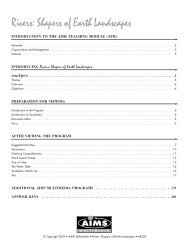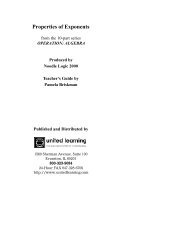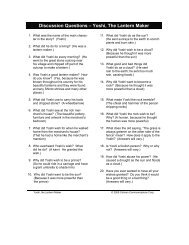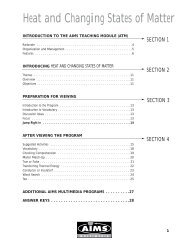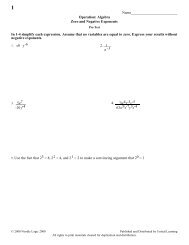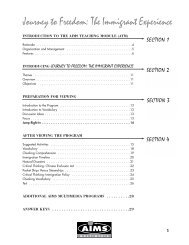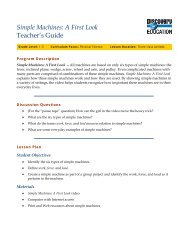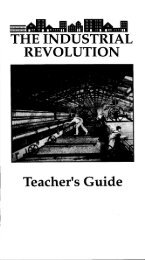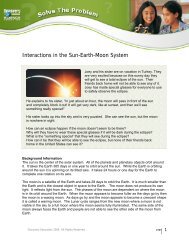The Geology of the Earth: Of Forces, Rocks, and Time - Discovery ...
The Geology of the Earth: Of Forces, Rocks, and Time - Discovery ...
The Geology of the Earth: Of Forces, Rocks, and Time - Discovery ...
Create successful ePaper yourself
Turn your PDF publications into a flip-book with our unique Google optimized e-Paper software.
<strong>The</strong> <strong>Geology</strong> <strong>of</strong> <strong>the</strong> <strong>Earth</strong>: <strong>Of</strong> <strong>Forces</strong>, <strong>Rocks</strong>, <strong>and</strong> <strong>Time</strong><br />
INTRODUCTION TO THE AIMS TEACHING MODULE (ATM)<br />
Rationale . . . . . . . . . . . . . . . . . . . . . . . . . . . . . . . . . . . . . . . . . . . . . . . . . . .4<br />
Organization <strong>and</strong> Management . . . . . . . . . . . . . . . . . . . . . . . . . . . . . . . . . . . .5<br />
Features . . . . . . . . . . . . . . . . . . . . . . . . . . . . . . . . . . . . . . . . . . . . . . . . . . . .6<br />
SECTION 1<br />
INTRODUCING THE GEOLOGY OF THE EARTH: OF FORCES, ROCKS, AND TIME<br />
<strong>The</strong>mes . . . . . . . . . . . . . . . . . . . . . . . . . . . . . . . . . . . . . . . . . . . . . . . . . . . .11<br />
Overview . . . . . . . . . . . . . . . . . . . . . . . . . . . . . . . . . . . . . . . . . . . . . . . . . .11<br />
Objectives . . . . . . . . . . . . . . . . . . . . . . . . . . . . . . . . . . . . . . . . . . . . . . . . . .11<br />
SECTION 2<br />
PREPARATION FOR VIEWING<br />
Introduction to <strong>the</strong> Program . . . . . . . . . . . . . . . . . . . . . . . . . . . . . . . . . . . . . .13<br />
Introduction to Vocabulary . . . . . . . . . . . . . . . . . . . . . . . . . . . . . . . . . . . . . . .13<br />
Discussion Ideas . . . . . . . . . . . . . . . . . . . . . . . . . . . . . . . . . . . . . . . . . . . . . .13<br />
Focus . . . . . . . . . . . . . . . . . . . . . . . . . . . . . . . . . . . . . . . . . . . . . . . . . . . . .13<br />
Jump Right In . . . . . . . . . . . . . . . . . . . . . . . . . . . . . . . . . . . . . . . . . . . . . . .14<br />
SECTION 3<br />
AFTER VIEWING THE PROGRAM<br />
Suggested Activities . . . . . . . . . . . . . . . . . . . . . . . . . . . . . . . . . . . . . . . . . . .15<br />
Vocabulary . . . . . . . . . . . . . . . . . . . . . . . . . . . . . . . . . . . . . . . . . . . . . . . . .18<br />
Checking Comprehension . . . . . . . . . . . . . . . . . . . . . . . . . . . . . . . . . . . . . . .19<br />
Geography Locations . . . . . . . . . . . . . . . . . . . . . . . . . . . . . . . . . . . . . . . . . .20<br />
True or False . . . . . . . . . . . . . . . . . . . . . . . . . . . . . . . . . . . . . . . . . . . . . . . .21<br />
Number Code . . . . . . . . . . . . . . . . . . . . . . . . . . . . . . . . . . . . . . . . . . . . . . .22<br />
<strong>Earth</strong> at a Glance . . . . . . . . . . . . . . . . . . . . . . . . . . . . . . . . . . . . . . . . . . . . .23<br />
Word Search . . . . . . . . . . . . . . . . . . . . . . . . . . . . . . . . . . . . . . . . . . . . . . . .24<br />
Test . . . . . . . . . . . . . . . . . . . . . . . . . . . . . . . . . . . . . . . . . . . . . . . . . . . . . . .25<br />
SECTION 4<br />
ADDITIONAL AIMS MULTIMEDIA PROGRAMS . . . . . . . . . .27<br />
ANSWER KEYS . . . . . . . . . . . . . . . . . . . . . . . . . . . . . . . .28<br />
1
© Copyright 1999 AIMS Multimedia<br />
All Rights Reserved. No part <strong>of</strong> this work may be reproduced or transmitted without written permission <strong>of</strong> AIMS<br />
Multimedia with <strong>the</strong>se exceptions: Persons or schools purchasing this AIMS Teaching Module may reproduce<br />
consumable ATM pages, identified in Section 4, for student or classroom use.<br />
AIMS Multimedia is a leading producer <strong>and</strong> distributor <strong>of</strong> educational programs serving schools <strong>and</strong> libraries for<br />
nearly 40 years. AIMS draws upon <strong>the</strong> most up-to-date knowledge, existing <strong>and</strong> emerging technologies, <strong>and</strong> all <strong>of</strong><br />
<strong>the</strong> instructional <strong>and</strong> pedagogical resources available to develop <strong>and</strong> distribute educational programs<br />
in film, videocassette, laserdisc, CD-ROM <strong>and</strong> CD-i formats.<br />
Persons or schools interested in obtaining additional copies <strong>of</strong> this AIMS Teaching Module, please contact:<br />
AIMS Multimedia<br />
1-800-FOR-AIMS<br />
1-800-367-2467<br />
2<br />
© Copyright 1999 AIMS Multimedia
Congratulations!<br />
You have chosen a learning program<br />
that will actively motivate your students<br />
AND provide you with easily accessible<br />
<strong>and</strong> easily manageable instructional<br />
guidelines designed to make your<br />
teaching role efficient <strong>and</strong> rewarding.<br />
<strong>The</strong> AIMS Teaching Module provides<br />
you with a video program keyed to your<br />
classroom curriculum, instructions <strong>and</strong><br />
guidelines for use, plus a comprehensive<br />
teaching program containing a<br />
wide range <strong>of</strong> activities <strong>and</strong> ideas for<br />
interaction between all content areas.<br />
Our authors, educators, <strong>and</strong> consultants<br />
have written <strong>and</strong> reviewed <strong>the</strong> AIMS<br />
Teaching Modules to align with <strong>the</strong><br />
Educate America Act: Goals 2000.<br />
This ATM, with its clear definition <strong>of</strong><br />
manageability, both in <strong>the</strong> classroom<br />
<strong>and</strong> beyond, allows you to tailor specific<br />
activities to meet all <strong>of</strong> your classroom<br />
needs.<br />
© Copyright 1999 AIMS Multimedia<br />
3
RATIONALE<br />
In today’s classrooms, educational pedagogy<br />
is <strong>of</strong>ten founded on Benjamin S.<br />
Bloom’s “Six Levels <strong>of</strong> Cognitive<br />
Complexity.” <strong>The</strong> practical application<br />
<strong>of</strong> Bloom’s Taxonomy is to evaluate students’<br />
thinking skills on <strong>the</strong>se levels,<br />
from <strong>the</strong> simple to <strong>the</strong> complex:<br />
Knowledge (rote memory skills),<br />
Comprehension (<strong>the</strong> ability to relate or<br />
retell), Application (<strong>the</strong> ability to apply<br />
knowledge outside its origin), Analysis<br />
(relating <strong>and</strong> differentiating parts <strong>of</strong> a<br />
whole), Syn<strong>the</strong>sis (relating parts to a<br />
whole), <strong>and</strong> Evaluation (making a judgment<br />
or formulating an opinion).<br />
<strong>The</strong> AIMS Teaching Module is designed<br />
to facilitate <strong>the</strong>se intellectual capabilities,<br />
AND to integrate classroom experiences<br />
<strong>and</strong> assimilation <strong>of</strong> learning<br />
with <strong>the</strong> students’ life experiences, realities,<br />
<strong>and</strong> expectations. AIMS’ learner<br />
verification studies prove that our AIMS<br />
Teaching Modules help students to<br />
absorb, retain, <strong>and</strong> to demonstrate ability<br />
to use new knowledge in <strong>the</strong>ir world.<br />
Our educational materials are written<br />
<strong>and</strong> designed for today’s classroom,<br />
which incorporates a wide range <strong>of</strong><br />
intellectual, cultural, physical, <strong>and</strong> emotional<br />
diversities.<br />
4<br />
© Copyright 1999 AIMS Multimedia
ORGANIZATION AND<br />
MANAGEMENT<br />
To facilitate ease in classroom manageability,<br />
<strong>the</strong> AIMS Teaching Module is<br />
organized in four sections. You are<br />
reading Section 1, Introduction to <strong>the</strong><br />
Aims Teaching Module (ATM).<br />
SECTION 2,<br />
INTRODUCING THIS ATM<br />
will give you <strong>the</strong> specific information<br />
you need to integrate <strong>the</strong> program into<br />
your classroom curriculum.<br />
SECTION 3,<br />
PREPARATION FOR VIEWING<br />
provides suggestions <strong>and</strong> strategies for<br />
motivation, language preparedness,<br />
readiness, <strong>and</strong> focus prior to viewing<br />
<strong>the</strong> program with your students.<br />
SECTION 4,<br />
AFTER VIEWING THE PROGRAM<br />
provides suggestions for additional<br />
activities plus an assortment <strong>of</strong> consumable<br />
assessment <strong>and</strong> extended activities,<br />
designed to broaden comprehension <strong>of</strong><br />
<strong>the</strong> topic <strong>and</strong> to make connections to<br />
o<strong>the</strong>r curriculum content areas.<br />
© Copyright 1999 AIMS Multimedia<br />
5
FEATURES<br />
INTRODUCING EACH ATM<br />
SECTION 2<br />
Your AIMS Teaching Module is<br />
designed to accompany a video program<br />
written <strong>and</strong> produced by some <strong>of</strong><br />
<strong>the</strong> world’s most credible <strong>and</strong> creative<br />
writers <strong>and</strong> producers <strong>of</strong> educational<br />
programming. To facilitate diversity <strong>and</strong><br />
flexibility in your classroom, your AIMS<br />
Teaching Module features <strong>the</strong>se components:<br />
<strong>The</strong>mes<br />
<strong>The</strong> Major <strong>The</strong>me tells how this AIMS<br />
Teaching Module is keyed into <strong>the</strong> curriculum.<br />
Related <strong>The</strong>mes <strong>of</strong>fer suggestions<br />
for interaction with o<strong>the</strong>r<br />
curriculum content areas, enabling<br />
teachers to use <strong>the</strong> teaching module to<br />
incorporate <strong>the</strong> topic into a variety <strong>of</strong><br />
learning areas.<br />
Overview<br />
<strong>The</strong> Overview provides a synopsis <strong>of</strong><br />
content covered in <strong>the</strong> video program.<br />
Its purpose is to give you a summary <strong>of</strong><br />
<strong>the</strong> subject matter <strong>and</strong> to enhance your<br />
introductory preparation.<br />
Objectives<br />
<strong>The</strong> ATM learning objectives provide<br />
guidelines for teachers to assess what<br />
learners can be expected to gain from<br />
each program. After completion <strong>of</strong> <strong>the</strong><br />
AIMS Teaching Module, your students<br />
will be able to demonstrate dynamic<br />
<strong>and</strong> applied comprehension <strong>of</strong> <strong>the</strong><br />
topic.<br />
6<br />
© Copyright 1999 AIMS Multimedia
PREPARATION FOR VIEWING<br />
SECTION 3<br />
In preparation for viewing <strong>the</strong> video<br />
program, <strong>the</strong> AIMS Teaching Module<br />
<strong>of</strong>fers activity <strong>and</strong>/or discussion<br />
ideas that you may use in any order<br />
or combination.<br />
Introduction To <strong>The</strong> Program<br />
Introduction to <strong>the</strong> Program is<br />
designed to enable students to recall<br />
or relate prior knowledge about <strong>the</strong><br />
topic <strong>and</strong> to prepare <strong>the</strong>m for what<br />
<strong>the</strong>y are about to learn.<br />
Introduction To Vocabulary<br />
Introduction to Vocabulary is a<br />
review <strong>of</strong> language used in <strong>the</strong> program:<br />
words, phrases, usage. This<br />
vocabulary introduction is designed to<br />
ensure that all learners, including limited<br />
English pr<strong>of</strong>iciency learners, will<br />
have full underst<strong>and</strong>ing <strong>of</strong> <strong>the</strong> language<br />
usage in <strong>the</strong> content <strong>of</strong> <strong>the</strong> program.<br />
Discussion Ideas<br />
Discussion Ideas are designed to help<br />
you assess students’ prior knowledge<br />
about <strong>the</strong> topic <strong>and</strong> to give students a<br />
preview <strong>of</strong> what <strong>the</strong>y will learn.<br />
Active discussion stimulates interest in<br />
a subject <strong>and</strong> can motivate even <strong>the</strong><br />
most reluctant learner. Listening, as<br />
well as speaking, is active participation.<br />
Encourage your students to participate<br />
at <strong>the</strong> rate <strong>the</strong>y feel<br />
comfortable. Model sharing personal<br />
experiences when applicable, <strong>and</strong><br />
model listening to students’ ideas <strong>and</strong><br />
opinions.<br />
Focus<br />
Help learners set a purpose for<br />
watching <strong>the</strong> program with Focus,<br />
designed to give students a focal<br />
point for comprehension continuity.<br />
Jump Right In<br />
Jump Right In provides abbreviated<br />
instructions for quick management <strong>of</strong><br />
<strong>the</strong> program.<br />
AFTER VIEWING THE PROGRAM<br />
SECTION 4<br />
After your students have viewed <strong>the</strong><br />
program, you may introduce any or<br />
all <strong>of</strong> <strong>the</strong>se activities to interact with<br />
o<strong>the</strong>r curriculum content areas, provide<br />
reinforcement, assess comprehension<br />
skills, or provide h<strong>and</strong>s-on<br />
<strong>and</strong> in-depth extended study <strong>of</strong> <strong>the</strong><br />
topic.<br />
© Copyright 1999 AIMS Multimedia<br />
7
SUGGESTED<br />
ACTIVITIES<br />
<strong>The</strong> Suggested Activities <strong>of</strong>fer ideas<br />
for activities you can direct in <strong>the</strong><br />
classroom or have your students complete<br />
independently, in pairs, or in<br />
small work groups after <strong>the</strong>y have<br />
viewed <strong>the</strong> program. To accommodate<br />
your range <strong>of</strong> classroom needs,<br />
<strong>the</strong> activities are organized into skills<br />
categories. <strong>The</strong>ir labels will tell you<br />
how to identify each activity <strong>and</strong> help<br />
you correlate it into your classroom<br />
curriculum. To help you schedule your<br />
classroom lesson time, <strong>the</strong> AIMS<br />
hourglass gives you an estimate <strong>of</strong> <strong>the</strong><br />
time each activity should require.<br />
Some <strong>of</strong> <strong>the</strong> activities fall into <strong>the</strong>se<br />
categories:<br />
Meeting Individual<br />
Needs<br />
<strong>The</strong>se activities are designed to aid in<br />
classroom continuity. Reluctant learners<br />
<strong>and</strong> learners acquiring English<br />
will benefit from <strong>the</strong>se activities<br />
geared to enhance comprehension <strong>of</strong><br />
language in order to fully grasp content<br />
meaning.<br />
MATH<br />
Curriculum<br />
Connections<br />
Many <strong>of</strong> <strong>the</strong> suggested activities are<br />
intended to integrate <strong>the</strong> content <strong>of</strong><br />
<strong>the</strong> ATM program into o<strong>the</strong>r content<br />
areas <strong>of</strong> <strong>the</strong> classroom curriculum.<br />
<strong>The</strong>se cross-connections turn <strong>the</strong><br />
classroom teaching experience into a<br />
whole learning experience.<br />
Critical Thinking<br />
Critical Thinking activities are<br />
designed to stimulate learners’ own<br />
opinions <strong>and</strong> ideas. <strong>The</strong>se activities<br />
require students to use <strong>the</strong> thinking<br />
process to discern fact from opinion,<br />
consider <strong>the</strong>ir own problems <strong>and</strong> formulate<br />
possible solutions, draw conclusions,<br />
discuss cause <strong>and</strong> effect, or<br />
combine what <strong>the</strong>y already know<br />
with what <strong>the</strong>y have learned to make<br />
inferences.<br />
Cultural Diversity<br />
Each AIMS Teaching Module has an<br />
activity called Cultural Awareness,<br />
Cultural Diversity, or Cultural<br />
Exchange that encourages students to<br />
share <strong>the</strong>ir backgrounds, cultures,<br />
heritage, or knowledge <strong>of</strong> o<strong>the</strong>r countries,<br />
customs, <strong>and</strong> language.<br />
H<strong>and</strong>s On<br />
<strong>The</strong>se are experimental or tactile<br />
activities that relate directly to <strong>the</strong><br />
material taught in <strong>the</strong> program.Your<br />
students will have opportunities to<br />
make discoveries <strong>and</strong> formulate ideas<br />
on <strong>the</strong>ir own, based on what <strong>the</strong>y<br />
learn in this unit.<br />
Writing<br />
Every AIMS Teaching Module will<br />
contain an activity designed for students<br />
to use <strong>the</strong> writing process to<br />
express <strong>the</strong>ir ideas about what <strong>the</strong>y<br />
have learned. <strong>The</strong> writing activity<br />
may also help <strong>the</strong>m to make <strong>the</strong> connection<br />
between what <strong>the</strong>y are learning<br />
in this unit <strong>and</strong> how it applies to<br />
o<strong>the</strong>r content areas.<br />
In <strong>The</strong> Newsroom<br />
Each AIMS Teaching Module contains<br />
a newsroom activity designed to help<br />
students make <strong>the</strong> relationship<br />
between what <strong>the</strong>y learn in <strong>the</strong> classroom<br />
<strong>and</strong> how it applies in <strong>the</strong>ir<br />
world. <strong>The</strong> purpose <strong>of</strong> In <strong>The</strong><br />
Newsroom is to actively involve each<br />
class member in a whole learning<br />
experience. Each student will have an<br />
opportunity to perform all <strong>of</strong> <strong>the</strong> tasks<br />
involved in production: writing,<br />
researching, producing, directing,<br />
<strong>and</strong> interviewing as <strong>the</strong>y create <strong>the</strong>ir<br />
own classroom news program.<br />
Extended Activities<br />
<strong>The</strong>se activities provide opportunities<br />
for students to work separately or<br />
toge<strong>the</strong>r to conduct fur<strong>the</strong>r research,<br />
explore answers to <strong>the</strong>ir own questions,<br />
or apply what <strong>the</strong>y have<br />
learned to o<strong>the</strong>r media or content<br />
areas.<br />
Link to <strong>the</strong> World<br />
<strong>The</strong>se activities <strong>of</strong>fer ideas for connecting<br />
learners’ classroom activities<br />
to <strong>the</strong>ir community <strong>and</strong> <strong>the</strong> rest <strong>of</strong> <strong>the</strong><br />
world.<br />
Culminating Activity<br />
To wrap up <strong>the</strong> unit, AIMS Teaching<br />
Modules <strong>of</strong>fer suggestions for ways to<br />
reinforce what students have learned<br />
<strong>and</strong> how <strong>the</strong>y can use <strong>the</strong>ir new<br />
knowledge to enhance <strong>the</strong>ir world<br />
view.<br />
8<br />
© Copyright 1999 AIMS Multimedia
VOCABULARY<br />
Every ATM contains an activity that<br />
reinforces <strong>the</strong> meaning <strong>and</strong> usage <strong>of</strong><br />
<strong>the</strong> vocabulary words introduced in<br />
<strong>the</strong> program content. Students will<br />
ei<strong>the</strong>r read or find <strong>the</strong> definition <strong>of</strong><br />
each vocabulary word, <strong>the</strong>n use <strong>the</strong><br />
word in a written sentence.<br />
CHECKING<br />
COMPREHENSION<br />
Checking Comprehension is designed<br />
to help you evaluate how well your<br />
students underst<strong>and</strong>, retain, <strong>and</strong><br />
recall <strong>the</strong> information presented in <strong>the</strong><br />
AIMS Teaching Module. Depending<br />
on your students’ needs, you may<br />
direct this activity to <strong>the</strong> whole group<br />
yourself, or you may want to have<br />
students work on <strong>the</strong> activity page<br />
independently, in pairs, or in small<br />
groups. Students can verify <strong>the</strong>ir written<br />
answers through discussion or by<br />
viewing <strong>the</strong> video a second time. If<br />
you choose, you can reproduce <strong>the</strong><br />
answers from your Answer Key or<br />
write <strong>the</strong> answer choices in a Word<br />
Bank for students to use. Students can<br />
use this completed activity as a study<br />
guide to prepare for <strong>the</strong> test.<br />
CONSUMABLE<br />
ACTIVITIES<br />
<strong>The</strong> AIMS Teaching Module provides<br />
a selection <strong>of</strong> consumable activities,<br />
designed to specifically reinforce <strong>the</strong><br />
content <strong>of</strong> this learning unit.<br />
Whenever applicable, <strong>the</strong>y are<br />
arranged in order from low to high<br />
difficulty level, to allow a seamless<br />
facilitation <strong>of</strong> <strong>the</strong> learning process.<br />
You may choose to have students take<br />
<strong>the</strong>se activities home or to work on<br />
<strong>the</strong>m in <strong>the</strong> classroom independently,<br />
in pairs or in small groups.<br />
CHECKING<br />
VOCABULARY<br />
<strong>The</strong> Checking Vocabulary activity<br />
provides <strong>the</strong> opportunity for students<br />
to assess <strong>the</strong>ir knowledge <strong>of</strong> new<br />
vocabulary with this word game or<br />
puzzle. <strong>The</strong> format <strong>of</strong> this vocabulary<br />
activity allows students to use <strong>the</strong><br />
related words <strong>and</strong> phrases in a different<br />
context.<br />
TEST<br />
<strong>The</strong> AIMS Teaching Module Test permits<br />
you to assess students’ underst<strong>and</strong>ing<br />
<strong>of</strong> what <strong>the</strong>y have learned.<br />
<strong>The</strong> test is formatted in one <strong>of</strong> several<br />
st<strong>and</strong>ard test formats to give your<br />
students a range <strong>of</strong> experiences in<br />
test-taking techniques. Be sure to<br />
read, or remind students to read, <strong>the</strong><br />
directions carefully <strong>and</strong> to read each<br />
answer choice before making a<br />
selection. Use <strong>the</strong> Answer Key to<br />
check <strong>the</strong>ir answers.<br />
© Copyright 1999 AIMS Multimedia<br />
9
ADDITIONAL<br />
AIMS MULTIMEDIA<br />
PROGRAMS<br />
After you have completed this AIMS<br />
Teaching Module you may be interested<br />
in more <strong>of</strong> <strong>the</strong> programs that AIMS<br />
<strong>of</strong>fers. This list includes several related<br />
AIMS programs.<br />
ADDITIONAL READING<br />
SUGGESTIONS<br />
AIMS <strong>of</strong>fers a carefully researched list <strong>of</strong><br />
o<strong>the</strong>r resources that you <strong>and</strong> your students<br />
may find rewarding.<br />
ANSWER KEY<br />
Reproduces tests <strong>and</strong> work pages with<br />
answers marked.<br />
10<br />
© Copyright 1999 AIMS Multimedia
<strong>The</strong> <strong>Geology</strong> <strong>of</strong> <strong>the</strong> <strong>Earth</strong>: <strong>Of</strong> <strong>Forces</strong>, <strong>Rocks</strong>, <strong>and</strong> <strong>Time</strong><br />
THEMES<br />
<strong>Geology</strong> <strong>of</strong> <strong>the</strong> <strong>Earth</strong>: <strong>Of</strong> <strong>Forces</strong>,<br />
<strong>Rocks</strong>, & <strong>Time</strong> discusses <strong>the</strong> physical<br />
makeup <strong>of</strong> <strong>the</strong> planet <strong>Earth</strong>, including<br />
<strong>the</strong> three major types <strong>of</strong> rocks—sedimentary,<br />
igneous, <strong>and</strong> metamorphic.<br />
It also discuss <strong>the</strong> major influences on<br />
<strong>the</strong> topographic geology <strong>of</strong> <strong>the</strong> <strong>Earth</strong>,<br />
including <strong>the</strong> wea<strong>the</strong>ring <strong>of</strong> rocks<br />
through wind, water, <strong>and</strong> gravity. In<br />
addition, <strong>the</strong> program covers major<br />
geologic events like earthquakes, volcanoes,<br />
<strong>and</strong> glacial movement.<br />
OVERVIEW<br />
<strong>The</strong> <strong>Earth</strong> hasn’t always looked <strong>the</strong><br />
way it does today. In fact, <strong>the</strong> process<br />
<strong>of</strong> wea<strong>the</strong>ring is constantly changing<br />
<strong>the</strong> face <strong>of</strong> <strong>Earth</strong>. <strong>The</strong> movement <strong>of</strong><br />
wind <strong>and</strong> water plays an important<br />
role in <strong>the</strong> changing l<strong>and</strong>scape. All <strong>of</strong><br />
<strong>the</strong> rocks on <strong>Earth</strong> originated as<br />
magma. <strong>The</strong>re are various types <strong>of</strong><br />
sedimentary rocks, like s<strong>and</strong>stone,<br />
shale, <strong>and</strong> conglomerates. <strong>The</strong> three<br />
major types <strong>of</strong> rocks, igneous, metamorphic,<br />
<strong>and</strong> sedimentary, represent<br />
different stages <strong>of</strong> <strong>the</strong> rock cycle.<br />
Humanity has also played a role in<br />
<strong>the</strong> geology <strong>of</strong> <strong>the</strong> <strong>Earth</strong> by burning<br />
fossil fuels which have caused acid<br />
rain, a particularly bad kind <strong>of</strong> chemical<br />
wea<strong>the</strong>ring. <strong>The</strong> geology <strong>of</strong> <strong>Earth</strong><br />
is dynamic <strong>and</strong> varied.<br />
OBJECTIVES<br />
<br />
<br />
<br />
<br />
To better underst<strong>and</strong> <strong>the</strong> rock<br />
cycle <strong>and</strong> <strong>the</strong> makeup <strong>of</strong> different<br />
types <strong>of</strong> rocks.<br />
To examine different types <strong>of</strong><br />
wea<strong>the</strong>ring <strong>and</strong> <strong>the</strong>ir effects on<br />
<strong>the</strong> topology <strong>of</strong> <strong>the</strong> <strong>Earth</strong>.<br />
To explore <strong>the</strong> effects <strong>of</strong> gravity<br />
on different types <strong>of</strong> rocks <strong>and</strong><br />
different regions <strong>of</strong> <strong>the</strong> planet.<br />
To look at different climates <strong>and</strong><br />
<strong>the</strong>ir geologic makeup.<br />
<br />
To determine <strong>the</strong> effect that<br />
glacial movement has had on <strong>the</strong><br />
<strong>Earth</strong>.<br />
© Copyright 1999 AIMS Multimedia <strong>The</strong> <strong>Geology</strong> <strong>of</strong> <strong>the</strong> <strong>Earth</strong>: <strong>Of</strong> <strong>Forces</strong>, <strong>Rocks</strong>, <strong>and</strong> <strong>Time</strong><br />
11
Use this page for your individual notes about planning <strong>and</strong>/or effective ways to manage this<br />
AIMS Teaching Module in your classroom.<br />
Our AIMS Multimedia Educational Department welcomes your observations <strong>and</strong> comments.<br />
Please feel free to address your correspondence to:<br />
AIMS Multimedia<br />
Editorial Department<br />
9710 DeSoto Avenue<br />
Chatsworth, California 91311-4409<br />
12<br />
© Copyright 1999 AIMS Multimedia <strong>The</strong> <strong>Geology</strong> <strong>of</strong> <strong>the</strong> <strong>Earth</strong>: <strong>Of</strong> <strong>Forces</strong>, <strong>Rocks</strong>, <strong>and</strong> <strong>Time</strong>
INTRODUCTION TO<br />
THE PROGRAM<br />
<strong>The</strong> study <strong>of</strong> geology, or “earth science,”<br />
encompasses many different<br />
sciences—mineralogy, meteorology,<br />
paleontology, volcanology <strong>and</strong> countless<br />
o<strong>the</strong>rs. But in one manner or<br />
ano<strong>the</strong>r, all <strong>of</strong> <strong>the</strong>se fields are concerned<br />
with <strong>the</strong> structure <strong>and</strong> composition<br />
<strong>of</strong> <strong>the</strong> <strong>Earth</strong>. Traditionally, <strong>the</strong><br />
study <strong>of</strong> <strong>the</strong> <strong>Earth</strong> has been broken<br />
down into two major areas: physical<br />
geology, <strong>the</strong> study <strong>of</strong> <strong>the</strong> materials<br />
<strong>and</strong> forces that make up <strong>the</strong> <strong>Earth</strong>,<br />
<strong>and</strong> historical geology, <strong>the</strong> history <strong>of</strong><br />
<strong>the</strong> <strong>Earth</strong>. Some geology can be<br />
tedious <strong>and</strong> minute, like determining<br />
<strong>the</strong> chemical composition <strong>of</strong> rocks,<br />
while o<strong>the</strong>r areas, like studying earthquakes,<br />
volcanoes, <strong>and</strong> glaciers can<br />
be dramatic <strong>and</strong> exciting.<br />
INTRODUCTION TO<br />
VOCABULARY<br />
Before starting <strong>the</strong> program, write <strong>the</strong><br />
following words on <strong>the</strong> board. Ask<br />
<strong>the</strong> class to discuss <strong>the</strong> meaning <strong>of</strong><br />
each word, <strong>and</strong> review <strong>the</strong> terms that<br />
are unfamiliar to students.<br />
geology - <strong>the</strong> study <strong>of</strong> <strong>the</strong> <strong>Earth</strong><br />
fossil - evidence <strong>of</strong> plant or animal<br />
life found on <strong>the</strong> surface <strong>of</strong> rocks or<br />
minerals<br />
rock - solid mineral matter found in<br />
or on <strong>the</strong> ground or <strong>the</strong> ocean’s surface<br />
DISCUSSION IDEAS<br />
<strong>Geology</strong> can be broken down into<br />
two major branches: physical geology<br />
<strong>and</strong> historical geology. Ask students<br />
what some possible differences<br />
between <strong>the</strong> two could be. What<br />
might a physical geologist do that a<br />
historical geologist would not do, <strong>and</strong><br />
vice versa (Physical geology is <strong>the</strong><br />
study <strong>of</strong> materials that make up <strong>the</strong><br />
<strong>Earth</strong> <strong>and</strong> forces that shape <strong>the</strong> <strong>Earth</strong>.<br />
Historical geology is <strong>the</strong> study <strong>of</strong> <strong>the</strong><br />
<strong>Earth</strong>’s history.)<br />
FOCUS<br />
Ask students to consider <strong>the</strong> importance<br />
<strong>of</strong> studying <strong>the</strong> history, formation<br />
<strong>and</strong> behavior <strong>of</strong> <strong>the</strong> <strong>Earth</strong>. How<br />
can learning about <strong>the</strong> <strong>Earth</strong> make<br />
our lives better <strong>and</strong> safer How can<br />
we use geology to help future generations<br />
<strong>of</strong> humans, plants <strong>and</strong> animals<br />
© Copyright 1999 AIMS Multimedia <strong>The</strong> <strong>Geology</strong> <strong>of</strong> <strong>the</strong> <strong>Earth</strong>: <strong>Of</strong> <strong>Forces</strong>, <strong>Rocks</strong>, <strong>and</strong> <strong>Time</strong><br />
13
JUMP RIGHT IN<br />
HOW TO USE THE GEOLOGY OF THE EARTH: OF FORCES, ROCKS, AND TIME AIMS TEACHING MODULE<br />
Preparation<br />
<br />
<br />
Read <strong>The</strong> <strong>Geology</strong> <strong>of</strong> <strong>the</strong> <strong>Earth</strong>:<br />
<strong>Of</strong> <strong>Forces</strong>, <strong>Rocks</strong>, <strong>and</strong> <strong>Time</strong><br />
<strong>The</strong>mes, Overview, <strong>and</strong><br />
Objectives to become familiar<br />
with program content <strong>and</strong> expectations.<br />
Use Preparation for Viewing<br />
suggestions to introduce <strong>the</strong> topic<br />
to students.<br />
Viewing THE GEOLOGY OF THE<br />
EARTH: OF FORCES, ROCKS, AND TIME<br />
<br />
<br />
<br />
Set up viewing monitor so that all<br />
students have a clear view.<br />
Depending on your classroom<br />
size <strong>and</strong> learning range, you may<br />
choose to have students view <strong>The</strong><br />
<strong>Geology</strong> <strong>of</strong> <strong>the</strong> <strong>Earth</strong>: <strong>Of</strong> <strong>Forces</strong>,<br />
<strong>Rocks</strong>, <strong>and</strong> <strong>Time</strong> toge<strong>the</strong>r or in<br />
small groups.<br />
Some students may benefit from<br />
viewing <strong>the</strong> video more than one<br />
time.<br />
After Viewing THE GEOLOGY OF<br />
THE EARTH: OF FORCES, ROCKS, AND<br />
TIME<br />
<br />
<br />
Select Suggested Activities that<br />
integrate into your classroom curriculum.<br />
If applicable, ga<strong>the</strong>r<br />
materials or resources.<br />
Choose <strong>the</strong> best way for students<br />
to work on each activity. Some<br />
activities work best for <strong>the</strong> whole<br />
group. O<strong>the</strong>r activities are<br />
designed for students to work<br />
independently, in pairs, or in<br />
small groups. Whenever possible,<br />
encourage students to share <strong>the</strong>ir<br />
work with <strong>the</strong> rest <strong>of</strong> <strong>the</strong> group.<br />
<br />
<br />
<br />
<br />
Duplicate <strong>the</strong> appropriate number<br />
<strong>of</strong> Vocabulary, Checking<br />
Comprehension, <strong>and</strong> consumable<br />
activity pages for your students.<br />
You may choose to have students<br />
take consumable activities home,<br />
or complete <strong>the</strong>m in <strong>the</strong> classroom,<br />
independently, or in<br />
groups.<br />
Administer <strong>the</strong> Test to assess students’<br />
comprehension <strong>of</strong> what<br />
<strong>the</strong>y have learned, <strong>and</strong> to provide<br />
<strong>the</strong>m with practice in test-taking<br />
procedures.<br />
Use <strong>the</strong> Culminating Activity<br />
as a forum for students to display,<br />
summarize, extend, or share<br />
what <strong>the</strong>y have learned with each<br />
o<strong>the</strong>r, <strong>the</strong> rest <strong>of</strong> <strong>the</strong> school, or a<br />
local community organization.<br />
14<br />
© Copyright 1999 AIMS Multimedia <strong>The</strong> <strong>Geology</strong> <strong>of</strong> <strong>the</strong> <strong>Earth</strong>: <strong>Of</strong> <strong>Forces</strong>, <strong>Rocks</strong>, <strong>and</strong> <strong>Time</strong>
SUGGESTED ACTIVITIES<br />
Connection to Geography<br />
Write <strong>the</strong> words “volcano” <strong>and</strong> “earthquake” on <strong>the</strong> board <strong>and</strong> ask students to list several<br />
places on <strong>the</strong> planet where each exists. Is <strong>the</strong>re some pattern What do volcanoes <strong>and</strong> earthquakes<br />
have in common<br />
(Many earthquakes <strong>and</strong> volcanoes take place on what is known as <strong>the</strong> “ring <strong>of</strong> fire,” an area<br />
that borders <strong>the</strong> Pacific tectonic plate. Areas where volcanoes <strong>and</strong> earthquakes exist border<br />
active tectonic plates, <strong>and</strong> <strong>the</strong> eruption <strong>of</strong> lava or <strong>the</strong> movement <strong>of</strong> <strong>the</strong> earth are both common<br />
occurrences for <strong>the</strong>se areas.)<br />
20 Minutes<br />
GEOGRAPHY<br />
H<strong>and</strong>s On<br />
Ice wedges are an important part <strong>of</strong> mechanical wea<strong>the</strong>ring. Allow students to watch as you<br />
perform <strong>the</strong> following experiment. Fill a shoebox with soil, <strong>the</strong>n firmly pack down <strong>the</strong> soil.<br />
Make a small crack with a knife <strong>and</strong> line <strong>the</strong> crack with plastic so it will hold water. Place water<br />
in <strong>the</strong> lined crack. Freeze <strong>the</strong> box. Did <strong>the</strong> soil move Melt <strong>the</strong> ice, add more water to fill <strong>the</strong><br />
plastic lining, <strong>and</strong> <strong>the</strong>n refreeze <strong>the</strong> water. What happened<br />
Extended <strong>Time</strong><br />
(<strong>The</strong> size <strong>of</strong> <strong>the</strong> space will increase, as it does in <strong>the</strong> case <strong>of</strong> an ice wedge.)<br />
Connection to Language Arts<br />
Ask students to explain <strong>the</strong> literal meaning <strong>of</strong> <strong>the</strong> word “geology.” What is <strong>the</strong> origin <strong>of</strong> <strong>the</strong><br />
word Ask students if <strong>the</strong>y know o<strong>the</strong>r words that contain <strong>the</strong> prefix geo- or <strong>the</strong> suffix -ology.<br />
What do <strong>the</strong>se words mean<br />
30 Minutes<br />
LANGUAGE<br />
ARTS<br />
(<strong>The</strong> word geology literally means <strong>the</strong> study <strong>of</strong> <strong>the</strong> earth. It comes from <strong>the</strong> Greek words ge,<br />
meaning <strong>Earth</strong>, <strong>and</strong> logos, meaning study. O<strong>the</strong>r terms originating from <strong>the</strong> word ge include<br />
geography, or <strong>the</strong> study <strong>of</strong> <strong>Earth</strong> as it relates to life; geometry, or <strong>the</strong> branch <strong>of</strong> ma<strong>the</strong>matics<br />
concerned with measuring various elements; <strong>and</strong> geomorphic, or that which relates to <strong>the</strong> form<br />
<strong>of</strong> <strong>the</strong> <strong>Earth</strong>.Words originating from <strong>the</strong> word logos include psychology, or <strong>the</strong> study <strong>of</strong> human<br />
behavior; sociology, or <strong>the</strong> study <strong>of</strong> human relationships <strong>and</strong> interaction; <strong>and</strong> biology, or <strong>the</strong><br />
study <strong>of</strong> life.)<br />
© Copyright 1999 AIMS Multimedia <strong>The</strong> <strong>Geology</strong> <strong>of</strong> <strong>the</strong> <strong>Earth</strong>: <strong>Of</strong> <strong>Forces</strong>, <strong>Rocks</strong>, <strong>and</strong> <strong>Time</strong><br />
15
Link to <strong>the</strong> World<br />
<strong>Geology</strong> can be divided into two basic subgroups: physical geology <strong>and</strong> historical geology.<br />
Within <strong>the</strong>se two subgroups, <strong>the</strong>re are many different branches <strong>of</strong> geological study. Ask students<br />
to discover as many <strong>of</strong> <strong>the</strong>se branches as <strong>the</strong>y can. What does each branch study Is it<br />
a branch <strong>of</strong> physical or historical geology, or both<br />
30 Minutes<br />
(Branches <strong>of</strong> physical geology include meteorology, or <strong>the</strong> study <strong>of</strong> wea<strong>the</strong>r; limnology, or <strong>the</strong><br />
study <strong>of</strong> inl<strong>and</strong> bodies <strong>of</strong> water; oceanography, or <strong>the</strong> study <strong>of</strong> <strong>the</strong> oceans; climatology, or <strong>the</strong><br />
study <strong>of</strong> <strong>Earth</strong>’s climate; geophysics, or <strong>the</strong> study <strong>of</strong> <strong>the</strong> structure <strong>and</strong> development <strong>of</strong> <strong>the</strong> <strong>Earth</strong>;<br />
mineralogy, or <strong>the</strong> study <strong>of</strong> rocks. Branches <strong>of</strong> historical geology include paleontology, or <strong>the</strong><br />
study <strong>of</strong> fossils; <strong>and</strong> stratigraphy, or <strong>the</strong> study <strong>of</strong> <strong>the</strong> layers <strong>of</strong> rock in <strong>the</strong> <strong>Earth</strong>’s crust. Branches<br />
that cover both physical <strong>and</strong> historical geology include sedimentology, or <strong>the</strong> study <strong>of</strong> sediment;<br />
<strong>and</strong> geochronology, or <strong>the</strong> study <strong>of</strong> geologic time.)<br />
Connection to History<br />
Humans have always been curious about <strong>the</strong> <strong>Earth</strong>. Since <strong>the</strong> time <strong>of</strong> <strong>the</strong> ancient Greeks, <strong>the</strong>y<br />
have wondered about <strong>the</strong> behavior <strong>of</strong> rocks, minerals <strong>and</strong> water. Ask each student to learn<br />
more about one <strong>of</strong> <strong>the</strong> subjects listed below. Using <strong>the</strong> Internet, library books <strong>and</strong> o<strong>the</strong>r<br />
resources, encourage <strong>the</strong>m to write a short paper describing <strong>the</strong>ir findings.<br />
<strong>The</strong> Agassiz Family<br />
Georgius Agricola<br />
Baron Cuvier<br />
James D. Dana<br />
Empedocles<br />
Galileo<br />
James Hall<br />
Adolph Knopf<br />
Sir Charles Lyell<br />
Strabo<br />
Eduard Suess<br />
HISTORY<br />
Extended <strong>Time</strong><br />
Writing<br />
Ask students to imagine that <strong>the</strong>y are sent to ano<strong>the</strong>r universe to meet extraterrestrial beings.<br />
How would <strong>the</strong> students describe <strong>Earth</strong> What would <strong>the</strong>y say about its history, its form <strong>and</strong> its<br />
physical behavior. Encourage <strong>the</strong>m to describe <strong>Earth</strong> as thoroughly as <strong>the</strong>y can in a two-page<br />
summary. Remind <strong>the</strong>m to include information about <strong>the</strong> <strong>Earth</strong>’s size, wea<strong>the</strong>r, atmosphere <strong>and</strong><br />
surface.<br />
Extended <strong>Time</strong><br />
16<br />
© Copyright 1999 AIMS Multimedia <strong>The</strong> <strong>Geology</strong> <strong>of</strong> <strong>the</strong> <strong>Earth</strong>: <strong>Of</strong> <strong>Forces</strong>, <strong>Rocks</strong>, <strong>and</strong> <strong>Time</strong>
Connection to Science<br />
Much <strong>of</strong> geology is concerned with <strong>the</strong> study <strong>of</strong> rocks. <strong>The</strong>re are three basic types <strong>of</strong> rock found<br />
on <strong>Earth</strong>: igneous rock, sedimentary rock <strong>and</strong> metamorphic rock. Ask students to describe how<br />
each type <strong>of</strong> rock was formed. Encourage <strong>the</strong>m to use dictionaries <strong>and</strong> encyclopedias if <strong>the</strong>y<br />
need help. Next, ask <strong>the</strong>m to provide an example <strong>of</strong> each type <strong>of</strong> rock.<br />
SCIENCE<br />
20 Minutes<br />
(Igneous rocks were formed when melted rock deep inside <strong>the</strong> <strong>Earth</strong>’s crust cooled <strong>and</strong> hardened.<br />
An example <strong>of</strong> igneous rock is granite. Sedimentary rocks were formed when pieces <strong>of</strong><br />
<strong>the</strong> <strong>Earth</strong>’s crust were worn away by water <strong>and</strong> wea<strong>the</strong>r. An example <strong>of</strong> a sedimentary rock is<br />
s<strong>and</strong>stone. Metamorphic rocks were formed when igneous <strong>and</strong> sedimentary rocks deep inside<br />
<strong>the</strong> <strong>Earth</strong>’s crust were changed by heat <strong>and</strong> <strong>the</strong> weight <strong>of</strong> <strong>the</strong> crust.)<br />
Meeting Individual Needs<br />
Ask students to make sentences using <strong>the</strong> following words. Encourage <strong>the</strong>m to use a dictionary<br />
if <strong>the</strong>y are uncertain <strong>of</strong> <strong>the</strong> meanings.<br />
• petroleum - deposits <strong>of</strong> oil found underground or beneath <strong>the</strong> ocean floor<br />
• gravitation - a force manifested by movement <strong>of</strong> two objects toward each o<strong>the</strong>r<br />
• paleontology - <strong>the</strong> study <strong>of</strong> <strong>the</strong> past geography <strong>of</strong> <strong>the</strong> <strong>Earth</strong><br />
• mineral - a solid crystalline element or compound that results from <strong>the</strong> inorganic processes<br />
<strong>of</strong> nature<br />
20 Minutes<br />
Culminating Activity<br />
During <strong>the</strong> late 1700s <strong>and</strong> early 1800s a great geological debate occurred concerning <strong>the</strong><br />
formation <strong>of</strong> rocks. Neptunists, such as Abraham Gottlob Werner, believed that an ocean<br />
had once covered <strong>the</strong> <strong>Earth</strong>. <strong>The</strong>y believed that chemicals in <strong>the</strong> water settled to <strong>the</strong> bottom<br />
<strong>and</strong> formed rocks. Plutonists, such as James Hutton, believed that hot lava from volcanoes<br />
formed rocks when it cooled. Since volcanoes continued to occur, Plutonists claimed that <strong>the</strong><br />
<strong>Earth</strong> was still changing.<br />
60 Minutes<br />
Divide students into two groups, with one group being Plutonists <strong>and</strong> <strong>the</strong> o<strong>the</strong>r being<br />
Neptunists. Using what <strong>the</strong>y have learned in <strong>the</strong> unit, ask members <strong>of</strong> each side to continue<br />
<strong>the</strong> great Rock Debate. Wait until after <strong>the</strong> debate to tell students which side eventually prevailed.<br />
© Copyright 1999 AIMS Multimedia <strong>The</strong> <strong>Geology</strong> <strong>of</strong> <strong>the</strong> <strong>Earth</strong>: <strong>Of</strong> <strong>Forces</strong>, <strong>Rocks</strong>, <strong>and</strong> <strong>Time</strong><br />
17
Name<br />
VOCABULARY<br />
<strong>The</strong> following terms are from <strong>The</strong> <strong>Geology</strong> <strong>of</strong> <strong>the</strong> <strong>Earth</strong>: <strong>Of</strong> <strong>Forces</strong>, <strong>Rocks</strong>, <strong>and</strong> <strong>Time</strong>. Fill in <strong>the</strong><br />
number <strong>of</strong> each term next to its closest definition.<br />
1. delta<br />
2. extrusive rock<br />
3. intrusive rock<br />
4. gorge<br />
5. magma<br />
6. mechanical wea<strong>the</strong>ring<br />
7. stalactites<br />
8. stalagmites<br />
9. chemical wea<strong>the</strong>ring<br />
10. igneous rock<br />
___<br />
___<br />
___<br />
___<br />
___<br />
___<br />
___<br />
___<br />
___<br />
___<br />
stone formations that usually hang from <strong>the</strong> ro<strong>of</strong>s <strong>of</strong> limestone caves<br />
rock formed by <strong>the</strong> cooling <strong>of</strong> magma<br />
<strong>the</strong> breaking down <strong>of</strong> rock by <strong>the</strong> effects <strong>of</strong> chemicals on <strong>the</strong> rock<br />
formed when magma solidifies into rock beneath <strong>the</strong> <strong>Earth</strong>’s surface<br />
a build up <strong>of</strong> sedimentary particles, usually occurring at <strong>the</strong> mouth <strong>of</strong> a river<br />
stone formations that usually rise from <strong>the</strong> floors <strong>of</strong> some limestone caves<br />
<strong>the</strong> molten material beneath <strong>the</strong> <strong>Earth</strong>’s crust<br />
formed when magma from beneath <strong>the</strong> <strong>Earth</strong>’s surface flows onto <strong>the</strong> surface, cools, <strong>and</strong><br />
hardens into rock<br />
<strong>the</strong> splitting <strong>of</strong> rocks by <strong>the</strong> expansion <strong>of</strong> water in cracks <strong>of</strong> <strong>the</strong> rock<br />
a narrow cut-out made through hard rock, usually <strong>the</strong> result <strong>of</strong> a rapidly<br />
descending mountain river<br />
18<br />
© Copyright 1999 AIMS Multimedia <strong>The</strong> <strong>Geology</strong> <strong>of</strong> <strong>the</strong> <strong>Earth</strong>: <strong>Of</strong> <strong>Forces</strong>, <strong>Rocks</strong>, <strong>and</strong> <strong>Time</strong>
Name<br />
CHECKING COMPREHENSION<br />
Read <strong>the</strong> following sentences <strong>and</strong> circle <strong>the</strong> letter <strong>of</strong> <strong>the</strong> word that best fills each blank.<br />
<strong>The</strong> <strong>Earth</strong> hasn’t always looked <strong>the</strong> way it does today. In fact, <strong>the</strong> process <strong>of</strong> __1__ is constantly<br />
changing <strong>the</strong> face <strong>of</strong> <strong>Earth</strong>. <strong>The</strong> movement <strong>of</strong> __2__ plays an important role in <strong>the</strong> changing l<strong>and</strong>scape.<br />
All <strong>of</strong> <strong>the</strong> rocks on <strong>Earth</strong> originated as __3__. <strong>The</strong>re are various types <strong>of</strong> __4__ rocks, like<br />
s<strong>and</strong>stone, shale, <strong>and</strong> conglomerates. Sedimentary rocks are generally formed by __5__. <strong>The</strong> three<br />
major types <strong>of</strong> rocks—igneous, metamorphic, <strong>and</strong> sedimentary—represent different stages <strong>of</strong> <strong>the</strong><br />
__6__. Humanity has also played a role in <strong>the</strong> geology <strong>of</strong> <strong>the</strong> <strong>Earth</strong> by burning fossil fuels which<br />
have caused __7__, a particularly bad kind <strong>of</strong> chemical wea<strong>the</strong>ring. L<strong>and</strong>slides, mudslides <strong>and</strong><br />
__8__ are all caused by gravity. <strong>The</strong> __9__ capacity <strong>of</strong> a river refers to <strong>the</strong> amount <strong>of</strong> sediment,<br />
s<strong>and</strong>, <strong>and</strong> rocks it can carry. <strong>The</strong>re are two types <strong>of</strong> glaciers: valley glaciers, like those in Alaska,<br />
<strong>and</strong> __10__ glaciers, like those in Antarctica.<br />
1. A. gravity<br />
B. sedimentation<br />
C. wea<strong>the</strong>ring<br />
D. magma<br />
2. A. wind<br />
B. glaciers<br />
C. water<br />
D. all <strong>of</strong> <strong>the</strong> above<br />
3. A. sedimentary rocks<br />
B. igneous rocks<br />
C. magma<br />
D. metamorphic rocks<br />
4. A. sedimentary<br />
B. basalt<br />
C. igneous<br />
D. metamorphic<br />
5. A. glaciers<br />
B. lava<br />
C. wind <strong>and</strong> water<br />
D. gravity<br />
6. A. <strong>Earth</strong>’s crust<br />
B. rock cycle<br />
C. intrusive cycle<br />
D. stalactite cycle<br />
7. A. magma<br />
B. stalagmites<br />
C. acid rain<br />
D. erosion<br />
8. A. creep<br />
B. s<strong>and</strong> dunes<br />
C. geysers<br />
D. extrusive rock formations<br />
9. A. flood bearing<br />
B. speed<br />
C. discharge<br />
D. load carrying<br />
10. A. sedimentary<br />
B. continental<br />
C. plate<br />
D. mountain<br />
© Copyright 1999 AIMS Multimedia <strong>The</strong> <strong>Geology</strong> <strong>of</strong> <strong>the</strong> <strong>Earth</strong>: <strong>Of</strong> <strong>Forces</strong>, <strong>Rocks</strong>, <strong>and</strong> <strong>Time</strong><br />
19
Name<br />
GEOLOGY LOCATIONS<br />
Place <strong>the</strong> letter <strong>of</strong> each location next to <strong>the</strong> phrase which best applies to it.<br />
A. Alaska<br />
B. Mississippi delta<br />
C. Gr<strong>and</strong> Canyon<br />
D. Himalayan Mountains<br />
E. Anasazi Indian caves<br />
F. California coast<br />
G. Great S<strong>and</strong> Dunes<br />
H. Bridalveil falls<br />
___<br />
___<br />
___<br />
___<br />
___<br />
___<br />
___<br />
___<br />
formed over thous<strong>and</strong>s <strong>of</strong> years because <strong>of</strong> <strong>the</strong> thawing <strong>and</strong> freezing <strong>of</strong> water<br />
<strong>the</strong> sight <strong>of</strong> frequent mudslides <strong>and</strong> l<strong>and</strong>slides<br />
valley glaciers are located here<br />
an area which contains large deposits <strong>of</strong> river sediment<br />
created by wind moving small particles <strong>of</strong> sediment<br />
caused by slow moving glaciers<br />
an example <strong>of</strong> sedimentary rock showing clear lines <strong>of</strong> stratification<br />
<strong>the</strong> result <strong>of</strong> colliding plates beneath <strong>the</strong> <strong>Earth</strong>’s surface<br />
20<br />
© Copyright 1999 AIMS Multimedia <strong>The</strong> <strong>Geology</strong> <strong>of</strong> <strong>the</strong> <strong>Earth</strong>: <strong>Of</strong> <strong>Forces</strong>, <strong>Rocks</strong>, <strong>and</strong> <strong>Time</strong>
Name<br />
TRUE OR FALSE<br />
Place a T next to statements that are true <strong>and</strong> an F next to statements that are false.<br />
1. ___ <strong>Rocks</strong> formed by <strong>the</strong> cooling <strong>of</strong> lava are called sedimentary rocks.<br />
2. ___ Most mountain ranges are made up <strong>of</strong> intrusive rocks like granite.<br />
3. ___ <strong>The</strong> rocks <strong>of</strong> <strong>the</strong> Gr<strong>and</strong> Canyon show layers <strong>of</strong> stratification.<br />
4. ___ Coal is an example <strong>of</strong> metamorphic rock.<br />
5. ___ Mechanical wea<strong>the</strong>ring occurs when <strong>the</strong> roots <strong>of</strong> a tree invade a rock <strong>and</strong> break it apart.<br />
6. ___ Mountain rivers typically flow slower than lowl<strong>and</strong> rivers.<br />
7. ___ Glaciers never existed as far south as Yosemite National Park.<br />
8. ___ S<strong>and</strong> dunes are caused by wind.<br />
9. ___ Marble is limestone that was heated <strong>and</strong> pressurized by natural forces.<br />
10. ___ Originally, <strong>the</strong> only types <strong>of</strong> rock on <strong>Earth</strong> were igneous <strong>and</strong> extrusive.<br />
© Copyright 1999 AIMS Multimedia <strong>The</strong> <strong>Geology</strong> <strong>of</strong> <strong>the</strong> <strong>Earth</strong>: <strong>Of</strong> <strong>Forces</strong>, <strong>Rocks</strong>, <strong>and</strong> <strong>Time</strong><br />
21
Name<br />
NUMBER CODE<br />
Use <strong>the</strong> code below to read <strong>the</strong> following facts about <strong>Earth</strong>.<br />
A = 1<br />
C = 2<br />
E = 3<br />
F = 4<br />
H = 5<br />
I = 6<br />
K = 7<br />
L = 8<br />
N = 9<br />
O = 10<br />
P = 11<br />
R = 12<br />
S = 13<br />
T = 14<br />
U = 15<br />
W = 16<br />
1. <strong>The</strong> <strong>Earth</strong> ranks 4-6-4-14-5 in size among <strong>the</strong> planets.<br />
__________________________<br />
2. <strong>The</strong> <strong>Earth</strong> is not perfectly round, but slightly flattened at <strong>the</strong> 11-10-8-3-12.<br />
__________________________<br />
3. Seventy perfect <strong>of</strong> <strong>the</strong> <strong>Earth</strong>’s 13-15-12-4-1-2-3 is comprised <strong>of</strong> water.<br />
__________________________<br />
4. All bodies <strong>of</strong> 16-1-14-3-12 make a portion <strong>of</strong> <strong>the</strong> <strong>Earth</strong> known as <strong>the</strong> hydrosphere.<br />
__________________________<br />
5. Almost half <strong>of</strong> <strong>the</strong> <strong>Earth</strong>’s 2-12-15-13-14 is comprised <strong>of</strong> oxygen.<br />
__________________________<br />
6. <strong>The</strong> core <strong>of</strong> <strong>the</strong> <strong>Earth</strong> is probably made <strong>of</strong> solid iron <strong>and</strong> 9-6-2-7-8-3.<br />
__________________________<br />
7. 12-1-6-9 is one <strong>of</strong> <strong>the</strong> most common forms <strong>of</strong> chemical wea<strong>the</strong>ring.<br />
__________________________<br />
8. Wind <strong>and</strong> water are primary causes <strong>of</strong> 3-12-10-13-6-10-9.<br />
__________________________<br />
22<br />
© Copyright 1999 AIMS Multimedia <strong>The</strong> <strong>Geology</strong> <strong>of</strong> <strong>the</strong> <strong>Earth</strong>: <strong>Of</strong> <strong>Forces</strong>, <strong>Rocks</strong>, <strong>and</strong> <strong>Time</strong>
Name<br />
EARTH AT A GLANCE<br />
Use an encyclopedia <strong>and</strong> o<strong>the</strong>r texts to fill in <strong>the</strong> blanks below.<br />
1. <strong>The</strong> <strong>Earth</strong>’s weight in tons:<br />
_____________________________________________<br />
2. Polar Diameter in miles (distance through <strong>the</strong> <strong>Earth</strong> from <strong>the</strong> North Pole to <strong>the</strong> South Pole):<br />
_____________________________________________<br />
3. Equatorial Diameter in miles (distance through <strong>the</strong> <strong>Earth</strong> at <strong>the</strong> equator):<br />
_____________________________________________<br />
4. Polar Circumference in miles (distance around <strong>the</strong> <strong>Earth</strong> through <strong>the</strong> poles):<br />
_____________________________________________<br />
5. Equatorial Circumference in miles (distance around <strong>the</strong> <strong>Earth</strong> at <strong>the</strong> equator):<br />
_____________________________________________<br />
6. Total Surface Area in square miles:<br />
_____________________________________________<br />
7. L<strong>and</strong> Area in square miles:<br />
_____________________________________________<br />
8. Water Area in square miles:<br />
_____________________________________________<br />
9. Highest Point on L<strong>and</strong> in feet:<br />
_____________________________________________<br />
10. Deepest Part <strong>of</strong> <strong>the</strong> Ocean in feet:<br />
_____________________________________________<br />
© Copyright 1999 AIMS Multimedia <strong>The</strong> <strong>Geology</strong> <strong>of</strong> <strong>the</strong> <strong>Earth</strong>: <strong>Of</strong> <strong>Forces</strong>, <strong>Rocks</strong>, <strong>and</strong> <strong>Time</strong><br />
23
Name<br />
WORD SEARCH<br />
<strong>The</strong> following words can be found in <strong>the</strong> maze below. <strong>The</strong> letters may be arranged horizontally,<br />
vertically, diagonally or backward.<br />
Mantle<br />
Polar<br />
Diamond<br />
Basalt<br />
Glacier<br />
Limestone<br />
Fossil<br />
Acid rain<br />
Himalaya<br />
Crust<br />
C H S R H F D R A L O P<br />
H M F O S G I D I A M N<br />
L A H I M A L A Y A L D<br />
I C S T N N C Y B S T I<br />
M E L T N A M L I M S A<br />
E D F O G L N E B E S M<br />
S G B N S T O F T F Y O<br />
T T L B G L N B Y O A N<br />
O N I A L F C R U S T D<br />
N A Y S C B S E O S T E<br />
E S B A C I D R A I N T<br />
L B S L I A E B R L E F<br />
M I S T B Y A R A T Y A<br />
24<br />
© Copyright 1999 AIMS Multimedia <strong>The</strong> <strong>Geology</strong> <strong>of</strong> <strong>the</strong> <strong>Earth</strong>: <strong>Of</strong> <strong>Forces</strong>, <strong>Rocks</strong>, <strong>and</strong> <strong>Time</strong>
Name<br />
TEST<br />
Circle <strong>the</strong> phrase which best answers each question.<br />
1. Oxidation is an example <strong>of</strong>:<br />
• mechanical wea<strong>the</strong>ring.<br />
• chemical wea<strong>the</strong>ring.<br />
• wind action.<br />
• erosion.<br />
2. <strong>The</strong> point at which a glacier’s rate <strong>of</strong> movement is equal to its rate <strong>of</strong> melting is <strong>the</strong>:<br />
• ice front.<br />
• terminal moraine.<br />
• lateral moraine.<br />
• medial moraine.<br />
3. Which <strong>of</strong> <strong>the</strong>se does not shape <strong>the</strong> <strong>Earth</strong>’s surface<br />
• glaciers<br />
• forces below <strong>the</strong> <strong>Earth</strong>’s crust<br />
• waves<br />
• basalt<br />
4. Conglomerates, s<strong>and</strong>stone, <strong>and</strong> shale are examples <strong>of</strong>:<br />
• intrusive rocks.<br />
• lava.<br />
• igneous rocks.<br />
• sedimentary rocks.<br />
5. <strong>The</strong> areas where plates come toge<strong>the</strong>r <strong>and</strong> move apart are prone to:<br />
• wind <strong>and</strong> rain storms.<br />
• glacial movement <strong>and</strong> melting.<br />
• high waves <strong>and</strong> tides.<br />
• <strong>the</strong> most geologic activity on <strong>Earth</strong>.<br />
© Copyright 1999 AIMS Multimedia <strong>The</strong> <strong>Geology</strong> <strong>of</strong> <strong>the</strong> <strong>Earth</strong>: <strong>Of</strong> <strong>Forces</strong>, <strong>Rocks</strong>, <strong>and</strong> <strong>Time</strong><br />
25
Name<br />
TEST (CONTINUED)<br />
6. <strong>The</strong> s<strong>and</strong> dunes at Death Valley are an example <strong>of</strong> shaping <strong>the</strong> <strong>Earth</strong> through:<br />
• earthquakes.<br />
• wind.<br />
• volcanic activity.<br />
• chemical wea<strong>the</strong>ring.<br />
7. “Acid Rain” is an example <strong>of</strong>:<br />
• chemical wea<strong>the</strong>ring.<br />
• industrial pollution.<br />
• a threat to plants <strong>and</strong> animals.<br />
• all <strong>of</strong> <strong>the</strong> above.<br />
8. Igneous rocks are formed by:<br />
• blowing wind.<br />
• erosion <strong>of</strong> <strong>the</strong> <strong>Earth</strong>’s crust.<br />
• cooling <strong>of</strong> <strong>the</strong> <strong>Earth</strong>’s crust.<br />
• cooling <strong>of</strong> magma.<br />
9. Diamond is an example <strong>of</strong>:<br />
• sedimentary rock.<br />
• igneous rock.<br />
• metamorphic rock.<br />
• a moraine.<br />
10. L<strong>and</strong>slides, mudslides, <strong>and</strong> creep are caused by:<br />
• wind.<br />
• gravity.<br />
• volcanic activity.<br />
• glacial moraines.<br />
26<br />
© Copyright 1999 AIMS Multimedia <strong>The</strong> <strong>Geology</strong> <strong>of</strong> <strong>the</strong> <strong>Earth</strong>: <strong>Of</strong> <strong>Forces</strong>, <strong>Rocks</strong>, <strong>and</strong> <strong>Time</strong>
ADDITIONAL AIMS MULTIMEDIA PROGRAMS<br />
You <strong>and</strong> your students might also enjoy <strong>the</strong>se o<strong>the</strong>r AIMS Multimedia programs:<br />
<strong>Earth</strong> Science Essentials Series<br />
<strong>The</strong> Universe: <strong>The</strong> Vast Frontier<br />
<strong>The</strong> Solar System: Our Neighbors in Space<br />
Oceans: Charting <strong>the</strong> Vastness<br />
Wea<strong>the</strong>r: <strong>The</strong> Chaos Which Surrounds Us<br />
<strong>The</strong> History <strong>of</strong> <strong>the</strong> <strong>Earth</strong>: Over <strong>the</strong> Eons<br />
© Copyright 1999 AIMS Multimedia <strong>The</strong> <strong>Geology</strong> <strong>of</strong> <strong>the</strong> <strong>Earth</strong>: <strong>Of</strong> <strong>Forces</strong>, <strong>Rocks</strong>, <strong>and</strong> <strong>Time</strong><br />
27
ANSWER KEY for page 18<br />
VOCABULARY<br />
<strong>The</strong> following terms are from <strong>The</strong> <strong>Geology</strong> <strong>of</strong> <strong>the</strong> <strong>Earth</strong>: <strong>Of</strong> <strong>Forces</strong>, <strong>Rocks</strong>, <strong>and</strong> <strong>Time</strong>. Fill in <strong>the</strong><br />
number <strong>of</strong> each term next to its closest definition.<br />
1. delta<br />
2. extrusive rock<br />
3. intrusive rock<br />
4. gorge<br />
5. magma<br />
6. mechanical wea<strong>the</strong>ring<br />
7. stalactites<br />
8. stalagmites<br />
9. chemical wea<strong>the</strong>ring<br />
10. igneous rock<br />
7<br />
___<br />
10<br />
___<br />
9<br />
___<br />
3<br />
___<br />
1<br />
___<br />
8<br />
___<br />
5<br />
___<br />
2<br />
___<br />
6<br />
___<br />
4<br />
___<br />
stone formations that usually hang from <strong>the</strong> ro<strong>of</strong>s <strong>of</strong> limestone caves<br />
rock formed by <strong>the</strong> cooling <strong>of</strong> magma<br />
<strong>the</strong> breaking down <strong>of</strong> rock by <strong>the</strong> effects <strong>of</strong> chemicals on <strong>the</strong> rock<br />
formed when magma solidifies into rock beneath <strong>the</strong> <strong>Earth</strong>’s surface<br />
a build up <strong>of</strong> sedimentary particles, usually occurring at <strong>the</strong> mouth <strong>of</strong> a river<br />
stone formations that usually rise from <strong>the</strong> floors <strong>of</strong> some limestone caves<br />
<strong>the</strong> molten material beneath <strong>the</strong> <strong>Earth</strong>’s crust<br />
formed when magma from beneath <strong>the</strong> <strong>Earth</strong>’s surface flows onto <strong>the</strong> surface, cools, <strong>and</strong><br />
hardens into rock<br />
<strong>the</strong> splitting <strong>of</strong> rocks by <strong>the</strong> expansion <strong>of</strong> water in cracks <strong>of</strong> <strong>the</strong> rock<br />
a narrow cut-out made through hard rock, usually <strong>the</strong> result <strong>of</strong> a rapidly<br />
descending mountain river<br />
28<br />
© Copyright 1999 AIMS Multimedia <strong>The</strong> <strong>Geology</strong> <strong>of</strong> <strong>the</strong> <strong>Earth</strong>: <strong>Of</strong> <strong>Forces</strong>, <strong>Rocks</strong>, <strong>and</strong> <strong>Time</strong>
ANSWER KEY for page 19<br />
CHECKING COMPREHENSION<br />
Read <strong>the</strong> following sentences <strong>and</strong> circle <strong>the</strong> letter <strong>of</strong> <strong>the</strong> word that best fills each blank.<br />
<strong>The</strong> <strong>Earth</strong> hasn’t always looked <strong>the</strong> way it does today. In fact, <strong>the</strong> process <strong>of</strong> __1__ is constantly<br />
changing <strong>the</strong> face <strong>of</strong> <strong>Earth</strong>. <strong>The</strong> movement <strong>of</strong> __2__ plays an important role in <strong>the</strong> changing l<strong>and</strong>scape.<br />
All <strong>of</strong> <strong>the</strong> rocks on <strong>Earth</strong> originated as __3__. <strong>The</strong>re are various types <strong>of</strong> __4__ rocks, like<br />
s<strong>and</strong>stone, shale, <strong>and</strong> conglomerates. Sedimentary rocks are generally formed by __5__. <strong>The</strong> three<br />
major types <strong>of</strong> rocks—igneous, metamorphic, <strong>and</strong> sedimentary—represent different stages <strong>of</strong> <strong>the</strong><br />
__6__. Humanity has also played a role in <strong>the</strong> geology <strong>of</strong> <strong>the</strong> <strong>Earth</strong> by burning fossil fuels which<br />
have caused __7__, a particularly bad kind <strong>of</strong> chemical wea<strong>the</strong>ring. L<strong>and</strong>slides, mudslides <strong>and</strong><br />
__8__ are all caused by gravity. <strong>The</strong> __9__ capacity <strong>of</strong> a river refers to <strong>the</strong> amount <strong>of</strong> sediment,<br />
s<strong>and</strong>, <strong>and</strong> rocks it can carry. <strong>The</strong>re are two types <strong>of</strong> glaciers: valley glaciers, like those in Alaska,<br />
<strong>and</strong> __10__ glaciers, like those in Antarctica.<br />
1. A. gravity<br />
B. sedimentation<br />
C. wea<strong>the</strong>ring<br />
D. magma<br />
2. A. wind<br />
B. glaciers<br />
C. water<br />
D. all <strong>of</strong> <strong>the</strong> above<br />
3. A. sedimentary rocks<br />
B. igneous rocks<br />
C. magma<br />
D. metamorphic rocks<br />
4. A. sedimentary<br />
B. basalt<br />
C. igneous<br />
D. metamorphic<br />
5. A. glaciers<br />
B. lava<br />
C. wind <strong>and</strong> water<br />
D. gravity<br />
6. A. <strong>Earth</strong>’s crust<br />
B. rock cycle<br />
C. intrusive cycle<br />
D. stalactite cycle<br />
7. A. magma<br />
B. stalagmites<br />
C. acid rain<br />
D. erosion<br />
8. A. creep<br />
B. s<strong>and</strong> dunes<br />
C. geysers<br />
D. extrusive rock formations<br />
9. A. flood bearing<br />
B. speed<br />
C. discharge<br />
D. load carrying<br />
10. A. sedimentary<br />
B. continental<br />
C. plate<br />
D. mountain<br />
© Copyright 1999 AIMS Multimedia <strong>The</strong> <strong>Geology</strong> <strong>of</strong> <strong>the</strong> <strong>Earth</strong>: <strong>Of</strong> <strong>Forces</strong>, <strong>Rocks</strong>, <strong>and</strong> <strong>Time</strong><br />
29
ANSWER KEY for page 20<br />
GEOLOGY LOCATIONS<br />
Place <strong>the</strong> letter <strong>of</strong> each location next to <strong>the</strong> phrase which best applies to it.<br />
A. Alaska<br />
B. Mississippi delta<br />
C. Gr<strong>and</strong> Canyon<br />
D. Himalayan Mountains<br />
E. Anasazi Indian caves<br />
F. California coast<br />
G. Great S<strong>and</strong> Dunes<br />
H. Bridalveil falls<br />
E<br />
___<br />
___<br />
F<br />
___<br />
A<br />
___ B<br />
___ G<br />
___ H<br />
___ C<br />
___ D<br />
formed over thous<strong>and</strong>s <strong>of</strong> years because <strong>of</strong> <strong>the</strong> thawing <strong>and</strong> freezing <strong>of</strong> water<br />
<strong>the</strong> sight <strong>of</strong> frequent mudslides <strong>and</strong> l<strong>and</strong>slides<br />
valley glaciers are located here<br />
an area which contains large deposits <strong>of</strong> river sediment<br />
created by wind moving small particles <strong>of</strong> sediment<br />
caused by slow moving glaciers<br />
an example <strong>of</strong> sedimentary rock showing clear lines <strong>of</strong> stratification<br />
<strong>the</strong> result <strong>of</strong> colliding plates beneath <strong>the</strong> <strong>Earth</strong>’s surface<br />
30<br />
© Copyright 1999 AIMS Multimedia <strong>The</strong> <strong>Geology</strong> <strong>of</strong> <strong>the</strong> <strong>Earth</strong>: <strong>Of</strong> <strong>Forces</strong>, <strong>Rocks</strong>, <strong>and</strong> <strong>Time</strong>
ANSWER KEY for page 21<br />
TRUE OR FALSE<br />
Place a T next to statements that are true <strong>and</strong> an F next to statements that are false.<br />
1. ___ F <strong>Rocks</strong> formed by <strong>the</strong> cooling <strong>of</strong> lava are called sedimentary rocks.<br />
2. ___ T Most mountain ranges are made up <strong>of</strong> intrusive rocks like granite.<br />
3. ___ T <strong>The</strong> rocks <strong>of</strong> <strong>the</strong> Gr<strong>and</strong> Canyon show layers <strong>of</strong> stratification.<br />
4. ___ F Coal is an example <strong>of</strong> metamorphic rock.<br />
5. ___ T Mechanical wea<strong>the</strong>ring occurs when <strong>the</strong> roots <strong>of</strong> a tree invade a rock <strong>and</strong> break it apart.<br />
6. ___ F Mountain rivers typically flow slower than lowl<strong>and</strong> rivers.<br />
7. ___ F Glaciers never existed as far south as Yosemite National Park.<br />
8. ___ T S<strong>and</strong> dunes are caused by wind.<br />
9. ___ T Marble is limestone that was heated <strong>and</strong> pressurized by natural forces.<br />
10. ___ F Originally, <strong>the</strong> only types <strong>of</strong> rock on <strong>Earth</strong> were igneous <strong>and</strong> extrusive.<br />
© Copyright 1999 AIMS Multimedia <strong>The</strong> <strong>Geology</strong> <strong>of</strong> <strong>the</strong> <strong>Earth</strong>: <strong>Of</strong> <strong>Forces</strong>, <strong>Rocks</strong>, <strong>and</strong> <strong>Time</strong><br />
31
ANSWER KEY for page 22<br />
NUMBER CODE<br />
Use <strong>the</strong> code below to read <strong>the</strong> following facts about <strong>Earth</strong>.<br />
A = 1<br />
C = 2<br />
E = 3<br />
F = 4<br />
H = 5<br />
I = 6<br />
K = 7<br />
L = 8<br />
N = 9<br />
O = 10<br />
P = 11<br />
R = 12<br />
1. <strong>The</strong> <strong>Earth</strong> ranks 4-6-4-14-5 in size among <strong>the</strong> planets.<br />
__________________________<br />
fifth<br />
2. <strong>The</strong> <strong>Earth</strong> is not perfectly round, but slightly flattened at <strong>the</strong> 11-10-8-3-12.<br />
__________________________<br />
poles<br />
3. Seventy perfect <strong>of</strong> <strong>the</strong> <strong>Earth</strong>’s 13-15-12-4-1-2-3 is comprised <strong>of</strong> water.<br />
__________________________<br />
surface<br />
4. All bodies <strong>of</strong> 16-1-14-3-12 make a portion <strong>of</strong> <strong>the</strong> <strong>Earth</strong> known as <strong>the</strong> hydrosphere.<br />
__________________________<br />
water<br />
5. Almost half <strong>of</strong> <strong>the</strong> <strong>Earth</strong>’s 2-12-15-13-14 is comprised <strong>of</strong> oxygen.<br />
__________________________<br />
crust<br />
6. <strong>The</strong> core <strong>of</strong> <strong>the</strong> <strong>Earth</strong> is probably made <strong>of</strong> solid iron <strong>and</strong> 9-6-2-7-8-3.<br />
__________________________<br />
nickel<br />
7. 12-1-6-9 is one <strong>of</strong> <strong>the</strong> most common forms <strong>of</strong> chemical wea<strong>the</strong>ring.<br />
__________________________<br />
Rain<br />
8. Wind <strong>and</strong> water are primary causes <strong>of</strong> 3-12-10-13-6-10-9.<br />
__________________________<br />
erosion<br />
32<br />
© Copyright 1999 AIMS Multimedia <strong>The</strong> <strong>Geology</strong> <strong>of</strong> <strong>the</strong> <strong>Earth</strong>: <strong>Of</strong> <strong>Forces</strong>, <strong>Rocks</strong>, <strong>and</strong> <strong>Time</strong>
ANSWER KEY for page 23<br />
EARTH AT A GLANCE<br />
Use an encyclopedia <strong>and</strong> o<strong>the</strong>r texts to fill in <strong>the</strong> blanks below.<br />
1. <strong>The</strong> <strong>Earth</strong>’s weight in tons:<br />
_____________________________________________<br />
6,600,000,000,000,000,000,000<br />
2. Polar Diameter in miles (distance through <strong>the</strong> <strong>Earth</strong> from <strong>the</strong> North Pole to <strong>the</strong> South Pole):<br />
_____________________________________________<br />
7,899.83 miles<br />
3. Equatorial Diameter in miles (distance through <strong>the</strong> <strong>Earth</strong> at <strong>the</strong> equator):<br />
_____________________________________________<br />
7,926.41<br />
4. Polar Circumference in miles (distance around <strong>the</strong> <strong>Earth</strong> through <strong>the</strong> poles):<br />
_____________________________________________<br />
24,859.82<br />
5. Equatorial Circumference in miles (distance around <strong>the</strong> <strong>Earth</strong> at <strong>the</strong> equator):<br />
_____________________________________________<br />
24,901.55<br />
6. Total Surface Area in square miles:<br />
_____________________________________________<br />
196,940,400<br />
7. L<strong>and</strong> Area in square miles:<br />
_____________________________________________<br />
57,280,000<br />
8. Water Area in square miles:<br />
_____________________________________________<br />
139,660,400<br />
9. Highest Point on L<strong>and</strong> in feet:<br />
_____________________________________________<br />
29,028 - Mt. Everest<br />
10. Deepest Part <strong>of</strong> <strong>the</strong> Ocean in feet:<br />
_____________________________________________<br />
36,198 - Challenger Deep in <strong>the</strong> Pacific Ocean<br />
© Copyright 1999 AIMS Multimedia <strong>The</strong> <strong>Geology</strong> <strong>of</strong> <strong>the</strong> <strong>Earth</strong>: <strong>Of</strong> <strong>Forces</strong>, <strong>Rocks</strong>, <strong>and</strong> <strong>Time</strong><br />
33
ANSWER KEY for page 24<br />
WORD SEARCH<br />
<strong>The</strong> following words can be found in <strong>the</strong> maze below. <strong>The</strong> letters may be arranged horizontally,<br />
vertically, diagonally or backward.<br />
Mantle<br />
Polar<br />
Diamond<br />
Basalt<br />
Glacier<br />
Limestone<br />
Fossil<br />
Acid rain<br />
Himalaya<br />
Crust<br />
C H S R H F D R A L O P<br />
H M F O S G I D I A M N<br />
L A H I M A L A Y A L D<br />
I C S T N N C Y B S T I<br />
M E L T N A M L I M S A<br />
E D F O G L N E B E S M<br />
S G B N S T O F T F Y O<br />
T T L B G L N B Y O A N<br />
O N I A L F C R U S T D<br />
N A Y S C B S E O S T E<br />
E S B A C I D R A I N T<br />
L B S L I A E B R L E F<br />
M I S T B Y A R A T Y A<br />
34<br />
© Copyright 1999 AIMS Multimedia <strong>The</strong> <strong>Geology</strong> <strong>of</strong> <strong>the</strong> <strong>Earth</strong>: <strong>Of</strong> <strong>Forces</strong>, <strong>Rocks</strong>, <strong>and</strong> <strong>Time</strong>
ANSWER KEY for page 25<br />
TEST<br />
Circle <strong>the</strong> phrase which best answers each question.<br />
1. Oxidation is an example <strong>of</strong>:<br />
• mechanical wea<strong>the</strong>ring.<br />
• chemical wea<strong>the</strong>ring.<br />
• wind action.<br />
• erosion.<br />
2. <strong>The</strong> point at which a glacier’s rate <strong>of</strong> movement is equal to its rate <strong>of</strong> melting is <strong>the</strong>:<br />
• ice front.<br />
• terminal moraine.<br />
• lateral moraine.<br />
• medial moraine.<br />
3. Which <strong>of</strong> <strong>the</strong>se does not shape <strong>the</strong> <strong>Earth</strong>’s surface<br />
• glaciers<br />
• forces below <strong>the</strong> <strong>Earth</strong>’s crust<br />
• waves<br />
• basalt<br />
4. Conglomerates, s<strong>and</strong>stone, <strong>and</strong> shale are examples <strong>of</strong>:<br />
• intrusive rocks.<br />
• lava.<br />
• igneous rocks.<br />
• sedimentary rocks.<br />
5. <strong>The</strong> areas where plates come toge<strong>the</strong>r <strong>and</strong> move apart are prone to:<br />
• wind <strong>and</strong> rain storms.<br />
• glacial movement <strong>and</strong> melting.<br />
• high waves <strong>and</strong> tides.<br />
• <strong>the</strong> most geologic activity on <strong>Earth</strong>.<br />
© Copyright 1999 AIMS Multimedia <strong>The</strong> <strong>Geology</strong> <strong>of</strong> <strong>the</strong> <strong>Earth</strong>: <strong>Of</strong> <strong>Forces</strong>, <strong>Rocks</strong>, <strong>and</strong> <strong>Time</strong><br />
35
ANSWER KEY for page 26<br />
TEST (CONTINUED)<br />
6. <strong>The</strong> s<strong>and</strong> dunes at Death Valley are an example <strong>of</strong> shaping <strong>the</strong> <strong>Earth</strong> through:<br />
• earthquakes.<br />
• wind.<br />
• volcanic activity.<br />
• chemical wea<strong>the</strong>ring.<br />
7. “Acid Rain” is an example <strong>of</strong>:<br />
• chemical wea<strong>the</strong>ring.<br />
• industrial pollution.<br />
• a threat to plants <strong>and</strong> animals.<br />
• all <strong>of</strong> <strong>the</strong> above.<br />
8. Igneous rocks are formed by:<br />
• blowing wind.<br />
• erosion <strong>of</strong> <strong>the</strong> <strong>Earth</strong>’s crust.<br />
• cooling <strong>of</strong> <strong>the</strong> <strong>Earth</strong>’s crust.<br />
• cooling <strong>of</strong> magma.<br />
9. Diamond is an example <strong>of</strong>:<br />
• sedimentary rock.<br />
• igneous rock.<br />
• metamorphic rock.<br />
• a moraine.<br />
10. L<strong>and</strong>slides, mudslides, <strong>and</strong> creep are caused by:<br />
• wind.<br />
• gravity.<br />
• volcanic activity.<br />
• glacial moraines.<br />
36<br />
© Copyright 1999 AIMS Multimedia <strong>The</strong> <strong>Geology</strong> <strong>of</strong> <strong>the</strong> <strong>Earth</strong>: <strong>Of</strong> <strong>Forces</strong>, <strong>Rocks</strong>, <strong>and</strong> <strong>Time</strong>



